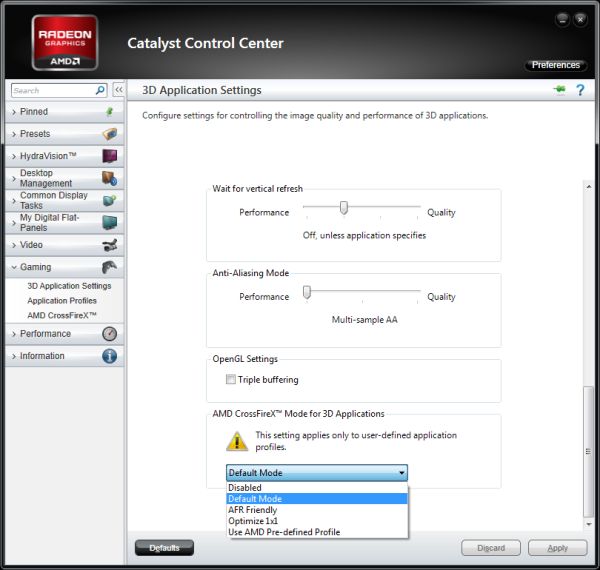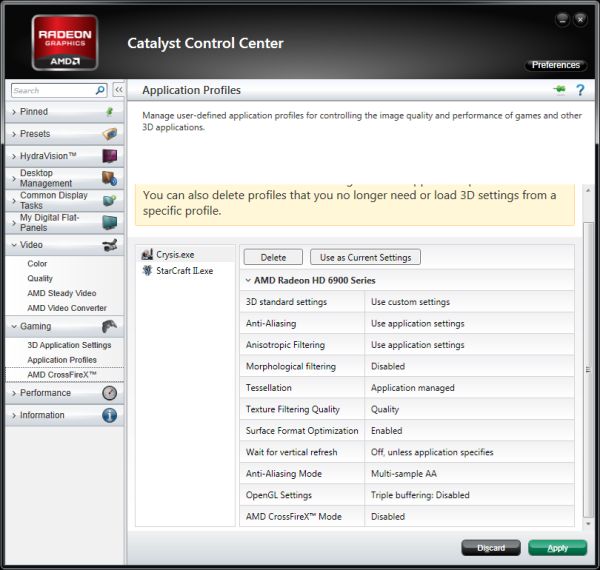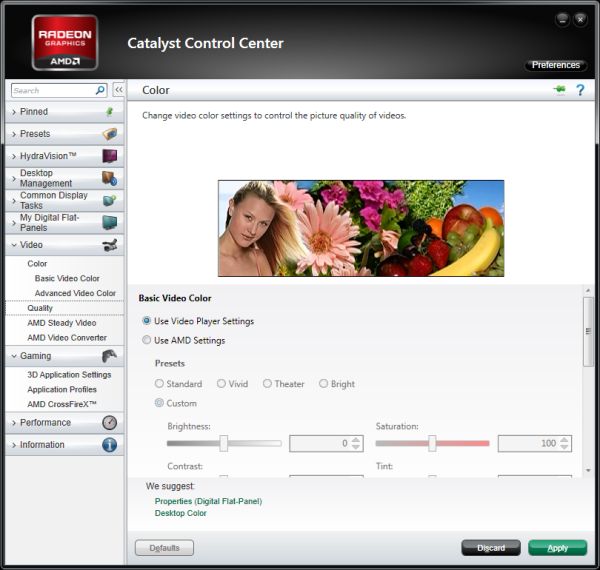AMD Releases Catalyst 12.1 Preview – Custom Application Profiles, HD3D CrossFire, & More
by Ryan Smith on December 13, 2011 1:00 AM ESTLater today AMD will be releasing the first preview for their Catalyst 12.1 driver set. AMD has been going through preview/beta drivers at a rapid pace in the last couple of months – we’ve seen 3 different 11.11 preview drivers in as many weeks – and as 11.12 nears, AMD is preparing for what 2012 and the Catalyst 12.x series will bring. It may sound like hyperbole to say that 2012 will be the biggest year yet for AMD’s Catalyst driver team, but it’s the truth. Graphics Core Next will be the biggest GPU architecture change for the company since R600 (2900XT) nearly 5 years ago, bringing with it a great deal of backend driver work that needs to be done, while the frontend team has their own goals and aspirations.
At the same time it’s going to give AMD the chance to close the book on 2011. 2011 brought with it some great developments out of the Catalyst team such as significant performance boosts for both Cayman (6900 series) GPUs and CrossFire across the board, while other groups delivered on more consumer-facing features such as SteadyVideo to go along with the launch of the Llano APU.
But 2011 also brought with it some technical debt and some reputational debt, all of which needs to be paid in 2012. AMD outright blew the launch of Rage by posting a faulty driver, Battlefield 3 in CrossFire mode did not work out of the box (i.e. without microstutter) even with nearly a month-long public beta and AMD’s close relationship with DICE, and CrossFire support for The Elder Scrolls V: Skyrim took the better part of a month to reach Radeon HD 5000 series owners. Not to kick the Catalyst team while they’re down, but for all that went well for them in 2011 they failed in other areas where they could least afford it. Thus 2012 becomes all the more important for AMD as they need to erase their debts from 2011.
Erasing those debts starts today for AMD, with the release of the Catalyst 12.1 preview driver. 12.1 won’t be the driver that buys AMD redemption – I think 11.11c is more important in that respect – but it is the driver that sets the pace for the year. And quite frankly it’s the driver that’s going to buy AMD a lot of goodwill, even if it only brings with it a few changes.

Custom Application Profiles As Implemented By NVIDIA
Of those few features I’m going to immediately dive in with what I think is the headline feature: custom application profiles. Ever since NVIDIA introduced custom application profiles so many years ago I have been a firm believer in their importance for GPU enthusiasts. While most games have been good about implementing anti-aliasing and anisotropic filtering controls, that’s about as much progress as they’ve made. With the introduction of driver enhancements like Adaptive/Transparancy anti-aliasing, coverage sample/EQ anti-aliasing, tessellation clamping, and the widespread use of multi-GPU, the idea that you can set & forget your drivers on a global level has become antiquated. These features deserve to be used, and custom application profiles are the most efficient way of using them.
For more than 4 years now I’ve asked AMD for this feature – in meetings and in articles – but it hasn’t been something where we’ve seen eye-to-eye. AMD made some progress in 2010 with the introduction of Catalyst Application Profiles (CAP) to distribute out of band profile updates, and while CAP was a big step forward for AMD, the C I was looking for was custom. Tools like Radeon Pro have filled the gap in the meantime, but it’s never the same thing as having such functionality built into the driver itself, especially when 3rd party tools will never have the reach of 1st party tools.
With Catalyst 12.1 AMD is finally taking application profiles to their logical extension by allowing for custom application profiles, and I couldn’t be happier. As is the case with NVIDIA, AMD is allowing users to create new application profiles and to modify the application profiles distributed through drivers and CAP updates. This not only includes settings traditionally available through the driver, but for the first time AMD is opening up CrossFire – you can now force various CrossFire modes by using a custom profile.
Breaking things down a bit, if you have used NVIDIA’s custom profiles in the past then you should find the functionality nearly the same. All of AMD’s control panel settings can be saved to a custom profile which will then be used alongside the game the profile is for. For example this allows for forcing MSAA in Starcraft II or clamping tessellation factors in HAWX 2 without the need to set (and then unset) these features at a global level. If you’re an image quality purist, and particularly if you’ve spent a significant amount of money on GPUs to achieve this, then the value of custom profiles cannot be understated.
As for multi-GPU users, they will be the other significant group to benefit from custom profiles. Previously if you wished to force CrossFire on an unsupported application you needed to rename the executable to match a game AMD had a profile for, and then hope that specific CF mode worked. With custom profiles AMD is enabling several different CF modes: default (which uses whatever CF profile AMD has defined for the game), AFR Friendly (forced AFR), Optimize 1x1, and Use AMD Pre-define Profile, which allows a custom profile to have a CF mode from another game mapped to it (similar to NVIDIA’s SLI compatibility bits). Even disabling CF on a per-profile basis is an option here, though we found that it suffers from the same quirk that NVIDIA’s implementation does: the second GPU is decoupled but CF isn’t actually disabled, so games that can detect CF (such as Crysis) will follow their AFR friendly render paths as they still see CF enabled.
At this point all of the necessary functionality is present and accounted for, and in our tests we’ve found it to work without any hitches. AMD is finally at parity with NVIDIA in providing this small but crucial feature.
With that said, while AMD has done a great job implementing the functionality of custom application profiles the interface could use some further work. The whole implementation still feels like it’s been shoehorned into AMD’s existing 3D Applications Setting panel; AMD doesn’t sufficiently separate the concept of global and custom profile settings, as you use the same control panel to make changes to both types of settings. It’s possible (and likely) that you’ll accidentally set your global settings at least once when trying to save a custom profile.
Furthermore whereas NVIDIA uses application detection to pre-populate a list of profiles, AMD has no such detection. In order to create a profile you need to first select your settings in the 3D Application Settings panel and then save those settings to a new profile, a process that involves hunting down the executable of the game. Of course NVIDIA’s detection system isn’t perfect and you’ll have to follow a similar process at times, but if you have a large Steam library you’ll appreciate not having to drill down through several directories to find the right executable for each game.
Once a custom profile has been set however, AMD actually has a second panel that lists all of the custom profiles and their settings, and allows you to delete them. Note that this is just a listing of custom profiles, so pre-defined profiles continue to remain hidden. Custom and pre-defined profiles play well together for the most part, although if you create a custom profile for a game that already has a pre-defined profile AMD will warn you that the custom profile will override the pre-defined profile.

Overall if you’re a previous NVIDIA user who has missed custom application profiles you should be quite content with AMD’s latest addition. Otherwise if you’ve never had the opportunity to use custom application profiles before then you’re in for a treat.
Rounding out the changes to the Catalyst Control Center, along with the addition of custom application profiles AMD has also made some minor tweaks to the Video Color and Video Quality control panels. There’s no new functionality to speak of, but they have been tweaked to simplify their use.
Finally, outside of the CCC AMD has also added a couple new features to their driver, along with some specific performance enhancements. 3D users will find that quad-buffer (gaming) 3D finally works in conjunction with CrossFire, while TV users will find that AMD now supports frame-packed 3D over HDMI at 1080p30, on top of their existing support for 1080p24 and 720p60. A quick check of the HDMI specification lists frame-packed 1080p30 as an optional (secondary) resolution, but it’s there for the TVs that support it. Meanwhile for performance AMD is still hard at work on Skyrim; 6900 series users can look forward to up to 10% better performance in Skyrim when using MSAA alongside CrossFire.
Update: Released. http://support.amd.com/us/kbarticles/Pages/Catalyst121Previewdriver.aspx




















59 Comments
View All Comments
james.jwb - Tuesday, December 13, 2011 - link
Wow, just wow...IceDread - Wednesday, December 14, 2011 - link
LOL go cry a river somewhere else.Stuka87 - Tuesday, December 13, 2011 - link
Wait.. what?What you just said does not make any sense. You are saying AMD has failed (at something, which you don't mention) and this is somehow some last straw attempt to fix things?!
The point of being able to make custom profiles is so that we can tweak each game the way we like it. Some game engines do better with some settings than others. There is no such thing as "one setting to rule them all" because each game engine is designed differently, and therefore settings will effect them differently. While nVidia/AMD can have issues with certain games individually, each game engine has more global issues that effect both card makers.
james.jwb - Tuesday, December 13, 2011 - link
On top of this, some games get old but are still played. Settings that were valid 2 years ago won't be now. Like I said, i now run Super-Sampling on some games and still get 60fps. Do you honestly expect AMD to update old game profiles for me? No, but now i can.Just because you fail to see the point, does not mean there isn't one, or some.
JonnyDough - Tuesday, December 13, 2011 - link
Best post.Samus - Tuesday, December 13, 2011 - link
Crossfire has, and always will be, a trailing rip-off of SLI. There's no room to argue that nVidia ripped-off SLI from 3Dfx because the implementations were completely different (only 3Dfx's last Voodoo5 5000-6000's were actually digital SLI, all early implementations were analoge alternating scan-lines)Crossfire clearly takes the SLI recipe but doesn't deliver a refined product. Microstutter, driver issues, compatibility, and performance are worse across-the-board on ATI Crossfire products.
-nVidia SLI has virtually no microstutter, where ATI products need a three-way configuration to eliminate it.
-ATI drivers have improved, but still show signs of the Rage-days. Features are missing, game compatibility is always poor at launch (Battlefield 3 is a good example) and I wouldn't consider them UNIFIED like nVidia drivers (you can still install a nVidia driver and it will support a Geforce 2 MX, ATI drivers stop at X1300)
-There is no room to argue that nVidia puts more effort into SLI profiles than ATI. No room. Currently over 400 games are supported by SLI, ~130 games are supported by Crossfire.
-Performance speaks for itself. SLI is faster in every situation comparable cards are teamed when compared to comparable ATI Crossfire cards.
JlHADJOE - Tuesday, December 13, 2011 - link
Last I recall, Nvidia bought 3Dfx. It's a bit hard to "rip-off" a feature you already own.silverblue - Wednesday, December 14, 2011 - link
"-nVidia SLI has virtually no microstutter, where ATI products need a three-way configuration to eliminate it."Not quite. NVIDIA still suffers, though not as much as AMD (not ATI, AMD) does:
http://www.tomshardware.com/reviews/radeon-geforce...
Yes, 3 cards does pretty much pull AMD back to the same level as NVIDIA, however it's not too outlandish to expect NVIDIA cards to suffer more in one or two titles than AMD ones.
"-ATI drivers have improved, but still show signs of the Rage-days. Features are missing, game compatibility is always poor at launch (Battlefield 3 is a good example) and I wouldn't consider them UNIFIED like nVidia drivers (you can still install a nVidia driver and it will support a Geforce 2 MX, ATI drivers stop at X1300)"
if you had a GeForce 2 MX system, I think you'd be a little annoyed downloading 61MB for the last ForceWare drivers made for such cards... in 2006. I will point out that the current GeForce drivers (285.62) support down to the GeForce 5 FX Series and not the GeForce 2 MX. In any case, if you wanted older ATI drivers, you could just locate them online. It's really not an issue.
"-Performance speaks for itself. SLI is faster in every situation comparable cards are teamed when compared to comparable ATI Crossfire cards."
AMD cards scale just as well if not more so with the 6-series cards. The aforementioned link shows SLi and CrossFire scaling in the same article.
SlyNine - Tuesday, December 13, 2011 - link
Wow, This comment takes the face palm of the day reward...Dude, you don't HAVE to tweak for the best performance, but of course you won't get the best performance. Most games all I have to do is set the resolution and in game settings, Or do you expect AMD to somehow do that through the drivers for you ????
This is just an OPTION so that if you do set things for one game (like SSAA) you don't have to go and reset the optimum settings for other games each time you play a different game, This makes things EASIER! If you don't want any hassles then DON'T FREKEN USE THE CCC AT ALL the defaults work fine for pretty much any game out there, with reduced image quality and/or performance. Better yet, go play on a console, but don't bitch because AMD just made it EASIER to tweak per game instead of having to do it on a global level.
Sabresiberian - Tuesday, December 13, 2011 - link
So, what you want to do is have the hardware read your mind and set the software preferences for you?These things are already automated as much as they can be, up until the point where the hardware and software have so much power they can run everything perfectly at max specs. Customizable profiles are a must because people view different aspects of what they see as more important - some might run with a lower frame rate for a higher quality image, for example, while others do it the other way around. Only you can decide what is the best way to tune your game (or other app) for you.
;)